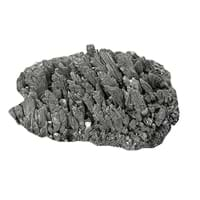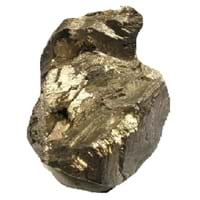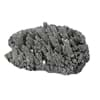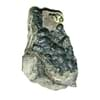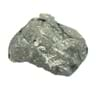Magnesium Bismuth Comparison
Periodic Table
Symbol
Mg
Bi
Group Number
2
16
15
3
Period Number
3
6
Block
s block
p block
Element Family
Alkaline Earth
Post-Transition
CAS Number
7439954
99+
7440699
22
Space Group Name
P63/mmc
C12/m1
Space Group Number
194.00
5
12.00
12
Facts
Interesting Facts
- Magnesium ions are present in every chlorophyll of every green plant .
- Controlling Magnesium fire by pouring water on it will result in explosions.
- Bismuth metal is soluble and reacts with concentrated nitric acid.
- It oxides are used as a yellow pigment in paint. Bismuth chloride oxide BiClO gives a pearly texture to cosmetics.
Sources
By Electrolysis Process, In Ocean, Mining
Found in Minerals, Mining, Ores of Minerals
History
Who Discovered
Joseph Black
Claude François Geoffroy
Discovery
In 1755
In 1753
Abundance
Abundance In Universe
6 * 10-2 %
2
7 * 10-8 %
25
Abundance In Sun
~0.07 %
2
~0.000006 %
14
Abundance In Meteorites
12.00 %
2
0.00 %
99+
Abundance In Earth's Crust
2.90 %
4
0.00 %
99+
Abundance In Oceans
0.13 %
2
0.00 %
24
Abundance In Humans
0.03 %
4
Not Available
Uses
Uses & Benefits
- Magnesium aluminum alloy improves the mechanical strength and welding characteristics and hence it is used in aeroplane and car manufacturing.
- It is also used to remove sulfur from the molten iron and steel.
- Tin and bismuth alloys have a very low melting point and hence it is used in fire detector and the fire extinguishers. It also used in electric solders and fuses.
Industrial Uses
Aerospace Industry, Ammunition Industry, Automobile Industry, Chemical Industry, Pharmaceutical Industry
Automobile Industry, Chemical Industry, Electrical Industry, Electronic Industry
Medical Uses
NA
Pharmaceutical Industry
Other Uses
Surgical Instruments Manufacturing
Alloys
Biological Properties
Toxicity
Non Toxic
Low Toxic
Present in Human Body
Yes
Yes
In Blood
37.80 Blood/mg dm-3
5
0.02 Blood/mg dm-3
20
In Bone
1,800.00 p.p.m.
4
0.20 p.p.m.
22
Physical Properties
Melting Point
650.00 °C
99+
271.30 °C
99+
Boiling Point
1,107.00 °C
99+
1,560.00 °C
99+
Appearance
Physical State
Solid
Solid
Color
Gray
Silver
Luster
NA
Metallic
Hardness
Mohs Hardness
2.50
14
2.25
15
Brinell Hardness
260.00 MPa
36
70.00 MPa
99+
Speed of Sound
4,940.00 m/s
11
1,790.00 m/s
99+
Optical Properties
Reflectivity
74.00 %
7
Not Available
Allotropes
No
No
α Allotropes
Not Available
Not Available
β Allotropes
Not Available
Not Available
γ Allotropes
Not Available
Not Available
Chemical Properties
Chemical Formula
Mg
Bi
Isotopes
Known Isotopes
15
24
33
6
Electronegativity
Pauling Electronegativity
1.31
31
2.02
6
Sanderson Electronegativity
1.32
18
2.34
3
Allred Rochow Electronegativity
1.23
25
1.67
6
Mulliken-Jaffe Electronegativity
1.37
16
2.15
4
Allen Electronegativity
1.29
35
2.01
4
Electropositivity
Pauling Electropositivity
2.69
23
1.98
99+
Ionization Energies
1st Energy Level
737.70 kJ/mol
24
703.00 kJ/mol
35
2nd Energy Level
1,450.70 kJ/mol
99+
1,610.00 kJ/mol
33
3rd Energy Level
7,732.70 kJ/mol
5
2,466.00 kJ/mol
99+
4th Energy Level
10,542.50 kJ/mol
4
4,370.00 kJ/mol
28
5th Energy Level
13,630.00 kJ/mol
3
5,400.00 kJ/mol
30
6th Energy Level
18,020.00 kJ/mol
3
8,520.00 kJ/mol
19
7th Energy level
21,711.00 kJ/mol
3
Not Available
8th Energy Level
25,661.00 kJ/mol
3
Not Available
9th Energy Level
31,653.00 kJ/mol
3
Not Available
10th Energy Level
35,458.00 kJ/mol
5
Not Available
11th Energy Level
169,988.00 kJ/mol
1
Not Available
12th Energy Level
189,368.00 kJ/mol
1
Not Available
Electrochemical Equivalent
0.45 g/amp-hr
99+
2.60 g/amp-hr
19
Electron Work Function
3.66 eV
29
4.22 eV
22
Other Chemical Properties
Corrosion, Highly Inflammable, Ionization, Solubility
Ionization, Radioactive Isotopes, Solubility
Atomic Properties
Atomic Number
12
99+
83
33
Electron Configuration
[Ne] 3s2
[Xe] 4f14 5d10 6s2 6p3
Crystal Structure
Hexagonal Close Packed (HCP)
Rhombohedral (RHO)
Crystal Lattice
HCP-Crystal-Structure-of-Magnesium.jpg#100
RHO-Crystal-Structure-of-Bismuth.jpg#100
Atom
Number of Protons
12
99+
83
33
Number of Neutrons
12
99+
126
18
Number of Electrons
12
99+
83
33
Radius of an Atom
Atomic Radius
160.00 pm
27
156.00 pm
29
Covalent Radius
141.00 pm
99+
148.00 pm
36
Van der Waals Radius
173.00 pm
37
207.00 pm
26
Atomic Weight
24.31 amu
99+
208.98 amu
29
Atomic Volume
13.97 cm3/mol
37
21.30 cm3/mol
14
Adjacent Atomic Numbers
Valence Electron Potential
40.00 (-eV)
99+
41.90 (-eV)
99+
Lattice Constant
320.94 pm
99+
667.40 pm
2
Lattice Angles
π/2, π/2, 2 π/3
NA
Lattice C/A Ratio
Not Available
Not Available
Mechanical Properties
Density
Density At Room Temperature
1.74 g/cm3
99+
9.78 g/cm3
39
Density When Liquid (at m.p.)
1.58 g/cm3
99+
10.05 g/cm3
18
Tensile Strength
Not Available
Not Available
Viscosity
Not Available
Not Available
Vapor Pressure
Elasticity properties
Shear Modulus
17.00 GPa
37
12.00 GPa
99+
Bulk Modulus
45.00 GPa
25
31.00 GPa
38
Young's Modulus
45.00 GPa
39
32.00 GPa
99+
Poisson Ratio
0.29
15
0.33
11
Other Mechanical Properties
NA
NA
Magnetic Properties
Magnetic Characteristics
Specific Gravity
1.74
99+
9.79
30
Magnetic Ordering
Paramagnetic
Diamagnetic
Permeability
Not Available
0.00 H/m
6
Susceptibility
Not Available
0.00
6
Electrical Properties
Electrical Property
Conductor
Semiconductor
Resistivity
43.90 nΩ·m
99+
1.29 nΩ·m
99+
Electrical Conductivity
0.23 106/cm Ω
7
0.01 106/cm Ω
99+
Electron Affinity
0.00 kJ/mol
40
91.20 kJ/mol
11
Thermal Properties
Specific Heat
1.02 J/(kg K)
4
0.12 J/(kg K)
40
Molar Heat Capacity
24.87 J/mol·K
99+
25.52 J/mol·K
37
Thermal Conductivity
156.00 W/m·K
8
7.97 W/m·K
99+
Critical Temperature
Not Available
Not Available
Thermal Expansion
24.80 µm/(m·K)
15
13.40 µm/(m·K)
28
Enthalpy
Enthalpy of Vaporization
128.70 kJ/mol
99+
151.00 kJ/mol
99+
Enthalpy of Fusion
8.95 kJ/mol
39
10.90 kJ/mol
33
Enthalpy of Atomization
148.50 kJ/mol
99+
207.10 kJ/mol
99+
Standard Molar Entropy
32.70 J/mol.K
99+
56.70 J/mol.K
24
|
||
|
||
|
